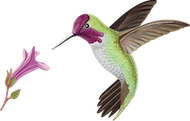As the Gottlieb Native Garden’s naturalist, Scott Logan documents the ever-changing array of wildlife species as they vary with the garden’s blooms, seasons and migratory patterns. While bringing these observations to life for all to experience, he also coordinates scientific research projects, and monitors the overall health and biodiversity of the garden. The Naturalist’s Journal also highlights the work the Gottliebs and Scott are doing to educate and inspire people to start gardening for wildlife with native plants.
Native Pollinators
One goal of the GNG is to create a healthy habitat for pollinators, especially native bees. California has over 1,600 species of native bees that come in many different sizes and adornments. One of the most common bee families in the world is the small […]
A Mule Deer’s New Antlers
This buck’s antlers are now just-fully grown and beginning to harden. We know this because in the last frames of the video you can see a strip of hanging velvet. As deer antlers harden and the velvet dries up, bucks will begin to rub them […]
Orange-crowned Warbler
Fall warbler migration is just upon us and Orange-crowned Warblers are leading the charge! A few orange-crowns have been seen recently in the GNG and we expect visits from many other warbler species as summer moves into fall.
Deception in the Garden
A carful walk in GNG may reveal an amazing form of survival. Many species of animals employ a wide variety of camouflage tactics, and one of these tricks is called background matching. Background matching is commonly used as camouflage, allowing an animal to blend […]
Orioles Have Started to Move South
This could be our last adult male Hooded Oriole camera capture for 2015 as their southward migration has begun. Females and juveniles should follow the adult males in a few weeks..
Vivid Dancer Damselflies
The Vivid Dancer is probably the most common damselfly in the Santa Monica Mountains, and at the moment they are abundant in the GNG. Even though they will ultimately lay their eggs in the upper pond (the lower pond does not have the ecosystem to […]
A Regular Nocturnal Visitor
Raccoons are photographed frequently by many of the GNG trail cameras. The lower pond is a favorite spot for raccoons, and the camera trap set-up here caught this rascal fishing for imaginary critters! Northern Raccoon – 1:16 am
Juvenile Fence Lizard
Coast Range Fence Lizards breed in the spring, and soon after females lay one to three clutches of around a dozen eggs each. By mid-summer, these eggs begin to hatch and juvenile fence lizards begin to appear. Without much effort, many of these young lizards […]
Coyote at the Lower Pond
Although we think of Coyotes as being nocturnal, it’s really not that unusual to see one out during the day. Coyotes are opportunistic feeders – regardless if it is day or night. And with so many diurnal California Ground Squirrels roaming the GNG these days, […]
Diverse Collection of Native Pollinators
Flower pollinators come in many shapes and sizes, including small flies. Hoverflies can be found busily doing an important job in the GNG, not only cross pollinating many native plants, but also keeping plant-damaging insects under control. The larvae of Allograpta obliqua are predators that feed […]

